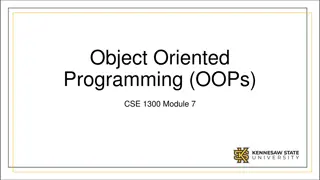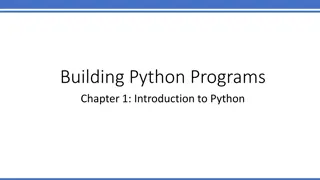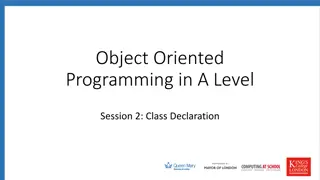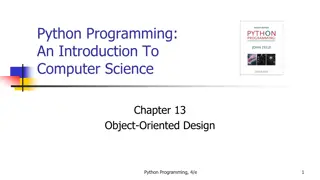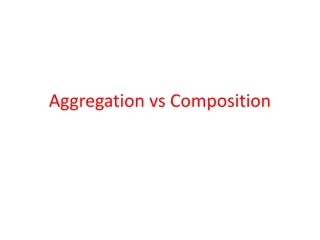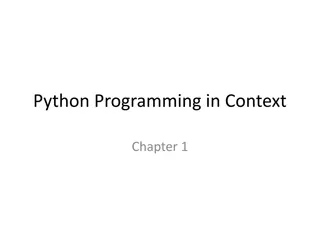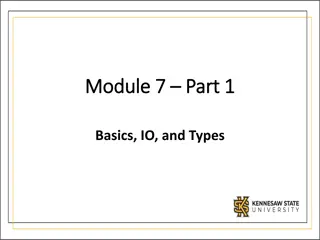
Python Object-Oriented Programming Basics
"Learn about OOP in Python with examples on classes, objects, and inheritance. Understand class structure, object instances, and basic operations. Get insights into working with data and creating class instances in Python."
Download Presentation

Please find below an Image/Link to download the presentation.
The content on the website is provided AS IS for your information and personal use only. It may not be sold, licensed, or shared on other websites without obtaining consent from the author. If you encounter any issues during the download, it is possible that the publisher has removed the file from their server.
You are allowed to download the files provided on this website for personal or commercial use, subject to the condition that they are used lawfully. All files are the property of their respective owners.
The content on the website is provided AS IS for your information and personal use only. It may not be sold, licensed, or shared on other websites without obtaining consent from the author.
E N D
Presentation Transcript
OOP IN PYTHON Peter Larsson-Green J nk ping University Autumn 2018
MODELLING The data ages = [43, 47, 10, 7, 3] def average(numbers): return sum(numbers)/len(numbers) Computations User Interface print("Average age: "+str(average(ages)))
MODELLING pets = [ {"type": "dog", "age": 2}, {"type": "cat", "age": 4} ] def get_average_age(pets): sum = 0 for pet in pets: if pet["type"] == "dog": sum += pet["age"] * 7 else: sum += pet["age"] * 4 return sum / len(pets) humans = [ {"name": "Alice", "age": 10}, {"name": "Bob", "age": 15} ] def get_average_age(humans): sum = 0 for human in humans: sum += human["age"] return sum / len(humans)
CLASSES AND OBJECTS A class is a description of/template for something. Use a class to describe a rectangle: Width & height Position Color Create 3 instances to represent your actual rectangles. Screen. Objects are instances of classes.
YOU HAVE ALREADY USED OOP All values in Python are objects. >>> a = 123 >>> type(a) <class 'int'> >>> b = "abc" >>> type(b) <class 'str'> >>> c = [1, 2] >>> type(c) <class 'list'>
CLASSES AND OBJECTS Objects are instances of classes. Consists of: Data fields (store values). as dicts! A class is a description of/template for objects. Consists of: Methods (defines what you can do with the objects). Constructor. Operations.
A SIMPLE CLASS The name of the class. class MyClass: pass Creates a new instance of the class. object_a = MyClass() object_a.three = 3 print(object_a.three) object_b = MyClass() object_b.three = "three" print(object_b.three) print(object_a.three) Prints: 3 Prints: three Prints: 3
THE CONSTRUCTOR class Circle: pass class Circle: def __init__(self): self.radius = 10 circle_a = Circle() circle_a.radius = 10 print(circle_a.radius) circle_b = Circle() circle_b.radius = 10 print(circle_b.radius) circle_a = Circle() print(circle_a.radius) circle_b = Circle() print(circle_b.radius)
THE CONSTRUCTOR class Circle: def __init__(self, radius): self.radius = radius class Circle: def __init__(self): self.radius = 10 small_circle = Circle(10) print(small_circle.radius) big_circle = Circle(200) print(big_circle.radius) circle_a = Circle() print(circle_a.radius) circle_b = Circle() print(circle_b.radius)
METHODS class Circle: def __init__(self, radius): self.radius = radius def get_area(self): return (self.radius ** 2) * 3.14 def get_perimeter(self): return self.radius * 2 * 3.14 my_circle = Circle(30) print(my_circle.get_area()) # Prints 2826. print(my_circle.get_perimeter()) # Prints 188.4.
EXAMPLE class Rectangle: def __init__(self, width, height): self.width = width self.height = height def get_area(self): return self.width * self.height def get_perimeter(self): return self.width*2 + self.height*2 rectangle = Rectangle(10, 20) print(rectangle.get_area()) # Prints 200. print(rectangle.get_perimeter()) # Prints 60.
EXAMPLE - CALCULATOR LAB 3 Enter initial memory value: 0 Enter operation (add/sub/quit): add Enter operand: 20 20 is stored in memory. Enter operation (add/sub/quit): sub Enter operand: 5 15 is stored in memory. Enter operation (add/sub/quit): quit We can use a class to represent the calculator. Need to keep track of the memory value. Need to be able to change the memory value (add/sub). calc = Calculator(0) calc.add(20) calc.subtract(5) calc.get_memory_value()
EXAMPLE - CALCULATOR LAB 3 class Calculator: def __init__(self, initial_memory_value): self.memory_value = initial_memory_value def add(self, operand): self.memory_value += operand def subtract(self, operand): self.memory_value -= operand def get_memory_value(self): return self.memory_value calc = Calculator(0) calc.add(20) calc.subtract(5) calc.get_memory_value()
EXAMPLE - CALCULATOR LAB 3 initial_memory_value = int(input("Enter initial memory value: ")) calculator = Calculator(initial_memory_value) operation = "" while operation != "quit": operation = input("Enter operation (add/sub/quit): ") if operation != "quit": operand = int(input("Enter operand: ")) if operation == "add": calculator.add(operand) elif operation == "sub": calculator.subtract(operand) print(str(calculator.get_memory_value())+" is stored in memory.")
DICE EXAMPLE from random import randint dice_value = randint(1, 6) print("You got: "+str(dice_value)+".") dice_value = randint(1, 6) print("You got "+str(dice_value)+".") class Dice: def __init__(self): self.roll() def roll(self): from random import randint self.number_of_pips = randint(1, 6) dice = Dice() print("You got: "+str(dice.number_of_pips)+".") dice.roll() print("You got: "+str(dice.number_of_pips)+".")
DICE EXAMPLE class SetOfDice: def __init__(self, number_of_dice): self.dice_list = [] for i in range(number_of_dice): self.dice_list.append(Dice()) def get_number_of_ones(self): count = 0 for dice in self.dice_list: if dice.number_of_pips == 1: count += 1 return count set_of_dice = SetOfDice(5) if set_of_dice.get_number_of_ones() == 0: print("Nice!") else: print("That's too bad.")
ROOM EXAMPLE class Room: def __init__(self, name, side_length_1, side_length_2): self.name = name self.side_length_1 = side_length_1 self.side_length_2 = side_length_2 def get_area(self): return self.side_length_1 * self.side_length_2 room1 = Room("Kitchen", 7, 5) print(room1.name+" is "+str(room1.get_area()+" m^2 big.")) room2 = Room("Bed Room", 3, 4) print(room2.name+" is "+str(room2.get_area()+" m^2 big."))
HOUSE EXAMPLE class House: def __init__(self): self.rooms = [] def add_room(self, room): self.rooms.append(room) def get_area(self): sum = 0 for room in self.rooms: sum += room.get_area() return sum my_house = House() my_house.add_room(Room("Kitchen", 7, 5)) my_house.add_room(Room("Bed Room", 3, 4)) area = my_house.get_area() print("Area of my house: "+str(area)+".")





